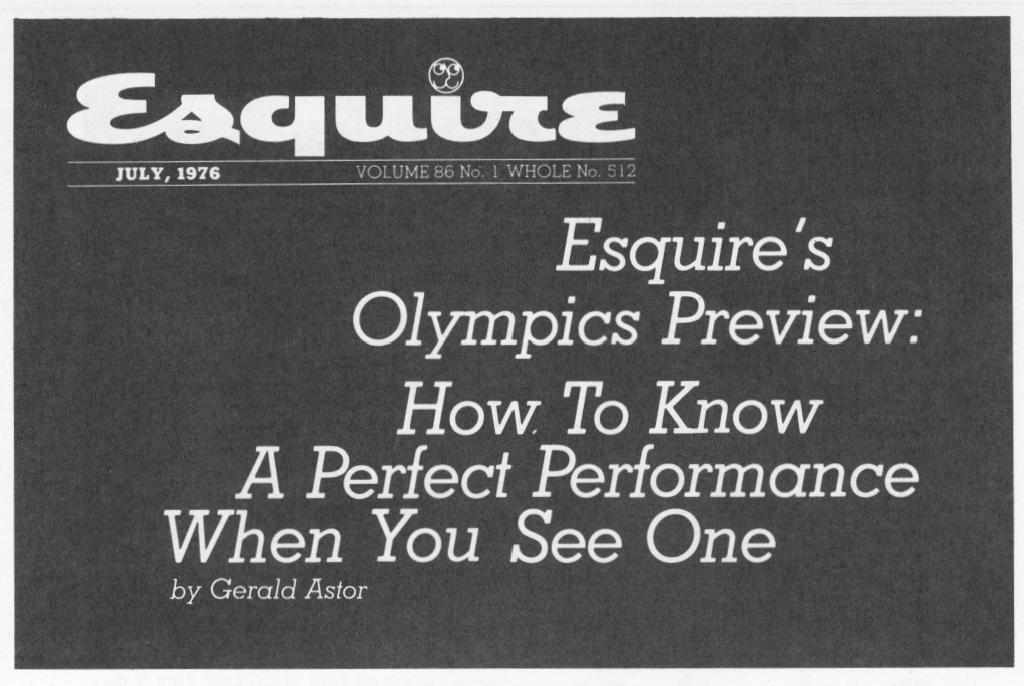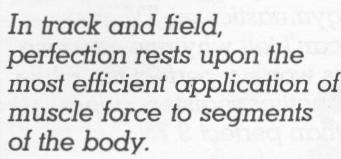| Index | Next |
O n July 17, to the accompaniment of booming cannons, flapping pigeons and assorted noise from the likes of the queen of England, a billion-dollar tribute to the pursuit of perfection opens at Montreal under the title of the Games of the XXI Olympiad. For the following fifteen days, ABC's TV cameras will long-lens, slow-motion, instant-replay, split-screen and stop-action the world's greatest athletes, who will run, jump, twist, heave, stroke, guide, steer and shoot in an orgy of excellence.
But perfection rarely holds still enough to be anatomized by a camera lens. Indeed, until commentator Jim McKay or his ilk advises us of the time, or a camera flashes on the scoreboard, we won't know whether a U.S. sprinter like Steve Williams has run a world record hundred meters or the Soviet Union's Olga Korbut has outdone Nadia Comaneci of Romania in the optional floor exercise for women gymnasts.
Even more significantly, the camera cannot show the mechanics employed by a body to produce a perfect shot put or a perfect Tsukahara vault. TV supplies a highly pleasurable caress to the visual sense-the same way Beethoven's Ninth Symphony provides an orgy of delight for the unschooled ear. But the enjoyment of athletics-as well as of music-increases
with an intellectual knowledge of the dynamics, whether it is Beethoven's manipulation of notes or Terry Albritton's manipulation of muscle tissue to move the shot seventy-one feet.
In track and field, perfection rests upon the most efficient application of muscle. force to segments of the body. Until
recently, techniques for running, jumping
and throwing improved haphazardly, mainly as a result of a challenger observing the style of a champion.
Shot-putters adopted the ways of Parry O'Brien in the 1950's until the latest generation of iron-ball men discovered by trial and error that a martini is not the only thing that's improved by a twist. The Western roll sufficed for the high jump until the straddle leapers reached higher altitudes. And now the flop method, which benefited from a rule change that permits the head to lead, owns the world record.
But where these refinements have all come out of guesswork and experimentation, science is now on the case in the person of Israeli-born Gideon
Ariel. As director of research for Computerized Biomechanical Analysis in Amherst, Massachusetts, Dr. Ariel's chief business is testing and designing athletic equipment that maximizes effective force. Since 1972, he has also been photographing athletes and feeding this visual data into a computer, which in turn spews out a graphic report in terms of force, direction of force, acceleration and velocity of body parts. The computer readouts give a quantitative measure of motion, from which Ariel sees what's necessary to perfect or optimize an athletic performance. The only limitations are those of muscle and ligament. Using data from medical science, Ariel knows at what point the forces exerted begin to tear human tissue.
What wins on paper, however, often runs out of the money at the track-except that Ariel has already astonished a number of expert skeptics. Last November he watched Mac Wilkins, a discus thrower (Ariel's own event as a 1964 Israeli Olympian). "Based on calculations I made," says the biomechanical engineer, "I could see Wilkins dissipated too much muscular force overcoming the friction between his shoe and the ground. I told him to pour water on the ground where his foot rested. He threw about two hundred thirty feet immediately. Until then, his best was two hundred fourteen feet. The water reduced the friction drag. A different shoe, one that lowered


| Index | Next |